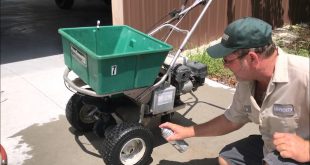Are you tired of planting crops that dry up before they mature?
Well, as a farmer, getting the essential tools required to keep your firm running is important. A key tool every farmer should have is a fertilizer spreader.
If used correctly, a fertilizer spreader is very efficient in weed killing, distribution of grass seeds and other garden products.
Our focus majorly will be on how the fertilizer spreader works and why you as farmer need it.
What is the importance of having a fertilizer spreader?
Applying the right amounts of products required
Do you often measure the amount of seedling used accurately? Probably not, but if you have a fertilizer spreader it assists in setting accurate and uniform spreading on all sides.
While putting in the recommended volume required in your garden.
Maintaining an attractive garden
Having an eye-catching garden can make you more interested in tilling your garden often. A fertilizer spreader avoids application of too little or too much proper seeds, chemicals or builder soil.
If they are applied in right amounts it keeps your garden in a good shape.
Keep your skin safe from chemicals
If you’re mostly using a homemade fertilizer there is a high risk of chemicals getting in contact with your skin. Having a fertilizer spreader is safe and accurate while dealing with fertilizers.
Time-saving
You no longer have to manually check each crop to see its progress. A fertilizer spreader can accurately apply fertilizer on your crops at the rate you wish. This saves a lot of energy and time.
What are the different types of fertilizers that are there and how do they function?
There are two main types of fertilizers spreaders. A broadcaster spreader and a drop spreader.
Both work differently but they have some similarities such as;
- They are both push powered.
- They have hoppers that contain adjustable holes at the bottom.
- Have a mounted gauge on the spreader handles bar that allows accurate settings on hole sizes
- Allow proper volume of material to uniformly exit the hopper.
- A flow lever which controls how the material drops on the garden by opening and closing a plate under hopper holes.
Drop spreader
In less than 24 hours it can lay the right amounts of material required in the width of the hopper. They work in smaller gardens with abundant flowerbeds and pavements.
However, you need to be careful of the spread pattern to avoid missing portions and making them too thick.
Broadcast spreaders
They work very well in big gardens. Its delivery is quick over a wide area. One of its wheels is geared so that you can push it.
The wheel turns an impeller plate that is under the hopper to throw away payload. Its fastness depends on your speeds.
How to use the fertilizer spreader?
- Measure the area you want to fertilize by using a tape measure across the width and the length and get its area.
- Move the fertilizer on the sidewalks close enough to flow lever which is near the handle.
- Pour proper amounts of fertilizer for area measured as you refer to the broadcast.
- Refer to your fertilizer bag and locate the rate dial and spread on or below the handle until you reach the rate as indicated on the bag.
- Place the spreader on the end of the area as you go round squeezing to dispense and stop once you’ve reached the beginning point.
- Continue applying the fertilizer until the whole area is fully covered.
- Water the area using a sprinkler or a pipe until the soil gets damp.
- Rinse properly to remove fertili zer residue.
Final thought.
I would recommend any farmer to purchase a fertilizer spreader. It helps in the application of appropriate products required in your garden.
 Lawn Zen
Lawn Zen


